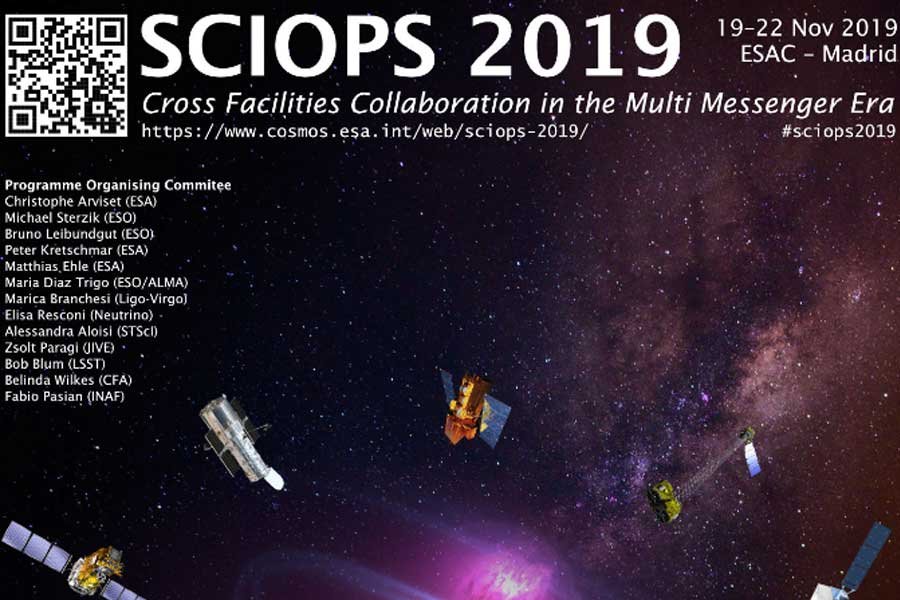
Nov 19, 2019 to Nov 22, 2019
|
Conferences & Events

The 4th ESA-ESO SCIOPS collaborative workshop 2019, in Madrid (Spain), took place between the 19th to 22nd November, focusing on the experiences gained in the last years in multi-mission, multi-wavelength and multi-messenger collaboration, on the challenges for the coming years and on ideas and approaches to tackle challenges in Astronomy.
With the observations of electromagnetic counterparts to gravitational wave events and to high-energy neutrinos, astrophysics has entered the multi-messenger era. New powerful survey facilities at different wavelengths are becoming reality and will hugely increase the number of potentially interesting targets in the next few years. A growing network of observatories is being made ready to follow up on exciting events. But the sheer number of expected follow-up targets and the complexities of collaboration and coordination among wide groups of researchers and different observatories poses many challenges to the existing means and ways of working.
ESCAPE was selected to do presentations on interoperable multi-messenger and on common challenges for FAIR astronomy data
Giuseppe Greco (ESCAPE partner and Italian National Research Council) presented "Interoperable multi-messenger approach for GW sky localization and EM follow-up: practical tools and methods supported by the ESCAPE project". Giuseppe presented strategies and implementations from ESCAPE to work with gravitational-wave sky localization information and connect the European Strategy Forum on Research Infrastructures (ESFRI) projects to the European Open Science Cloud (EOSC) through the Virtual Observatory (VO) framework. ESCAPE demonstrated how how gravitational-wave sky maps can be easily and efficiently visualized and processed using Multi-Order Coverage (MOC) maps for fast tiling, catalog queries, transient localizations, visibility and sky map comparisons. MOC is a standard of the Virtual Observatory (VO) which provides a multi-scale mapping based on HEALPix sky tessellation. Practical examples will be discussed in the frameworkof the the alert messages sent by the LIGO and Virgo collaborations during the O3 observational run. Finally, we will present the recent MOC extension to support time and space coverage and the effectiveness of the proposed strategies to organize the electromagnetic-followup observations for interoperable and fast data exchange.
Mark Allen (ESCAPE partner and Observatoire de Strasbourg) did a presentation entitled "Addressing common challenges for FAIR astronomy data". The presentation also mentioned how ESCAPE Virtual Observatory (VO) aims to be a key for discovery and reuse, using common disciplinary International Virtual Observatory Alliance (IVOA) standards and fostering good practices for data access, deposition and sharing of data, as well as for data management curation and preservation. The ESCAPE VO will be a pioneer of data sharing with a well established alliance of international partners who cooperate to build the necessary interoperability standards.
Both presentations had as audience communities from both ESO and ESA, concerned with how to "cross-facilitate" coordination in the multi-messenger era, who became more aware about this challenges, as well as how to produce that that will support open science.